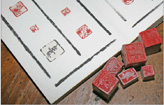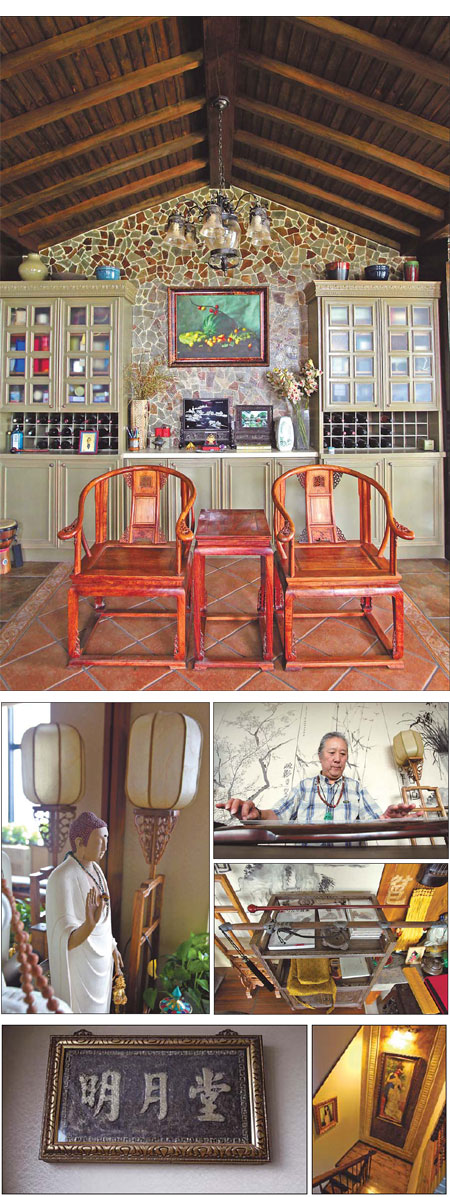Heritage
Homedisplay
Updated: 2011-06-12 08:44
By Gan Tian (China Daily)
|
Clockwise from top The Ming-style armchairs take pride of place in the living room. Yang Qing's passion for old furniture is rooted in his love for the guqin. Yang's other extensive collections provide a setting for his prized musical instruments. Pear wood gives the rooms a calm feeling. Calligraphy is an important part of Yang's home scene. Even the decorative statues are chosen to reflect the warm wood tones Yang favors. Photos by Wang Jing |

Gan Tian talks to two experts on how to care for and keep cultural and antique collections in the home.
He has no love for cold, angular Western furniture. Instead, two ancient round-backed Chinese armchairs take pride of place in his apartment, the centerpieces in a home full of traditional Chinese furniture and musical instruments.
For Yang Qing, 60, the vice-president of the Society of Traditional Chinese Musical Instruments, his motivation for collecting traditional Chinese furniture has nothing to do with money. Instead, it's all about the setting.
It starts with his love of the guqin, a seven-stringed Chinese zither. In Yang's home in Beijing's Chaoyang district, the decor revolves around this classic instrument.
For Yang, it is unimaginable to see himself perched on a Western-style chair and placing his guqin on a Western coffee table. He needed the right props to set the mood.
He started searching for furniture made of Chinese pear wood almost 20 years ago, beginning with an ancient armchair that had the right ergonomics for playing the guqin comfortably. After a couple of months, Yang added other chairs that would complement this chair. And then he fell in love with the style.
"Some like to collect expensive Chinese wooden furniture as investment, but for me, it is just part of my life. I collect them to use them," Yang says. Furniture that is used takes on a patina of warmth that mirrors the love that goes into them. Sometimes, the wood has other effects.
For example, pear wood is used in traditional Chinese medicine to help decrease blood pressure. As furniture, the subtle fragrance and presence of the pear wood introduce a calming effect to the room.
Yang says Chinese wooden furniture must be used, although carefully to avoid deep scratches and damage.
"If you use them, they become 'alive', because these pieces need people to get close to them. Using them is the best way to preserve them," Yang says.
The same principle applies to the pieces of jade used for decor. Yang handles his jade accessories frequently.
"If a jade piece is touched and fondled by its owner frequently, it will become more attractive," Yang says. According to Chinese tradition, the cool jade absorbs the warmth of its owner and glows as a result.
Chinese painting and calligraphy scrolls are also often used in the home for decor. These fragile pieces of art need special handling as well.
According to Zeng Jun, director of the Ancient Paintings Department in the Palace Museum, scrolls and calligraphies are the most delicate among all the antiquities.
While there is plenty of advanced and complicated equipment to help store ancient scrolls and calligraphies in the Palace Museum, ordinary homeowners may feel ill equipped to exhibit and store them.
There are a few simple steps to protect your collections.
A scroll should not be kept rolled up inside a box for the whole time, or hung up in the living room for too long. The best way is to alternate the exhibit - hanging the scrolls out for one or two months at a time in between keeping them in cool, dry places.
Keep them dust-free, especially in the cities where the pollution index is high. Dust destroys the pigments in the paintings and hastens biodegradation of the paper and silk scrolls.
Yang sums it up with a poetic visualization: A Chinese scholar dressed in a traditional Chinese gown plucks at a guqin on a delicately carved pear wood table. Tucked away by the side of his gown is a jade pendant with a silk tassel. On another pear wood table behind him, a piece of antique jade sits, glistening in the lamplight. Behind him, the chiseled window frames let in soft moonlight, which falls on the scrolls of painting and calligraphy on the wall.
It's all about the setting.
E-paper

Pearl on the Yangtze
Wuxi is considered a town of natural beauty and its motto is "city of water and warmth".
Prose and consternation
Riding on a mystery train
Way of a warrior
Specials

When two are one
After a separation of 360 years, Huang Gongwang's famous Dwelling in the Fuchun Mountains has been made whole again.

Wealth of difference
Rich coastal areas offer contrasting ways of dealing with country's development

Seal of approval
The dying tradition of seal engraving has now become a UNIVERSITY major

